Originally Posted At: https://breakingmuscle.com/feed/rss
Everybody’s keen on boasting about their squat numbers, but many people overlook single-leg work. That’s a pity because unilateral exercises — single-arm or single-leg movements — offer unique benefits such as avoiding overusing the dominant side, isolating and correcting muscle or strength imbalances, improving balance, body awareness and preventing injuries.
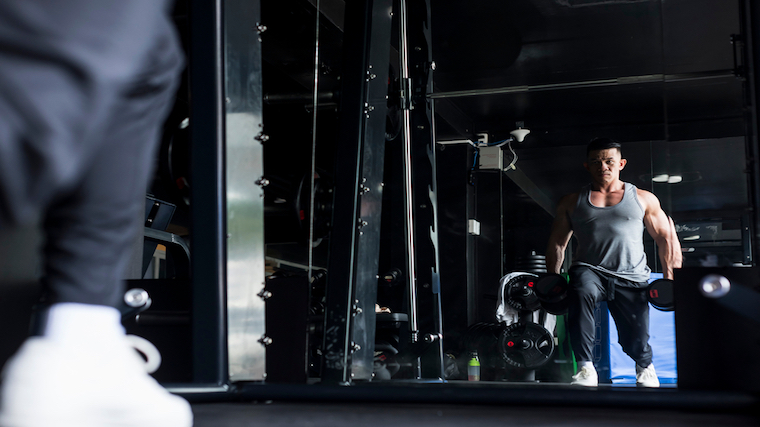
Lunges are the main “squatting” pattern unilateral exercise, and as such should be a primary exercise in your training regimen. Lunges are a very adaptable, easy exercise to program, and they can be performed a myriad of ways. Today we’re taking a look at the dumbbell reverse lunge, a staple exercise that every lifter should have in their toolbox.
Don’t miss out on lunges, for this basic exercise has a lot to offer. Here’s everything you need to know about the dumbbell reverse lunge.
- How to Do the Reverse Lunge
- Reverse Lunge Mistakes to Avoid
- Benefits of the Reverse Lunge
- Muscles Worked by the Reverse Lunge
- Who Should Do the Reverse Lunge
- How to Program the Reverse Lunge
- Reverse Lunge Variations
- Reverse Lunge Alternatives
- Frequently Asked Questions
How To Do The Reverse Lunge
As a unilateral exercise, the lunge requires more balance and coordination than you may be used to. Fail to execute the lunge as intended and, at best, the movement won’t be effective and, at worst, you risk injury. Here’s a step-by-step guide to performing the lunge perfectly.
Step 1 — Find Your Stride Backwards
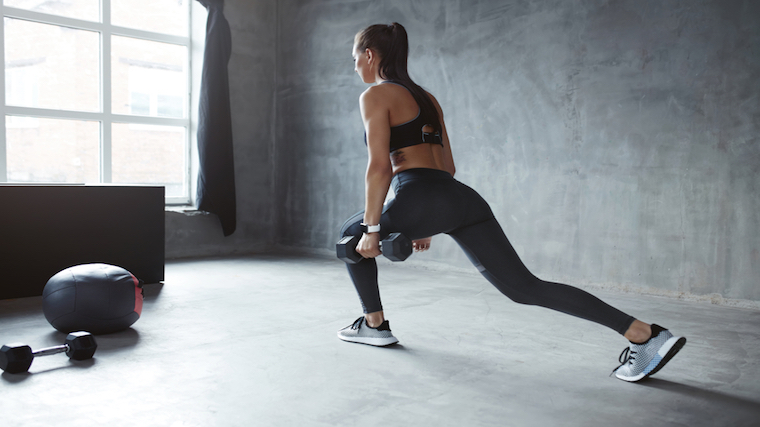
Grab a pair of dumbbells or kettlebells and stand tall with your feet together. Take a step backwards, keeping the majority of your weight on your front foot. Use the rear foot mostly for balance, and only have your toes on the floor.
The length of the step will vary depending on your anatomy as well as which muscles you hope to target. A shorter stride will engage the quadriceps more, while a longer step better targets the glutes and hamstrings. Establish the stride you want and keep it the same across repetitions.
Form tip: Find your stride length without weight at first, so that you can warm-up and minimize injury risks. Using too narrow of a stance, or a stride that is too long or short, will cause balance issues that will undermine the exercise’s efficiency. Find what feels comfortable for you and stick with that.
Step 2 — Sink Down and Graze the Floor With Your Knee
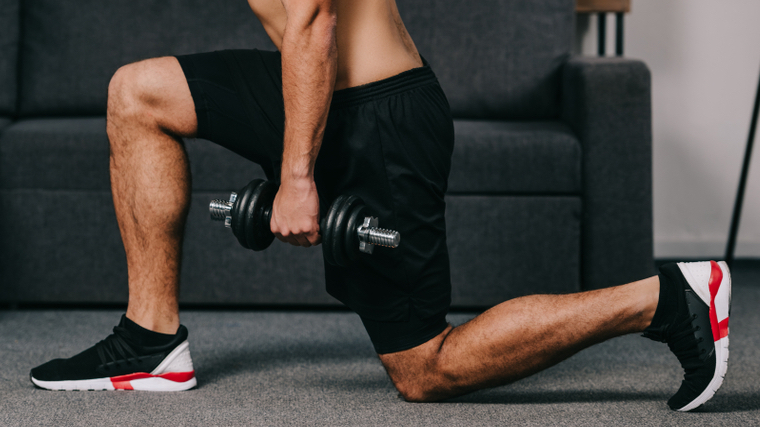
Brace your core and then bend at the knees while keeping most of your weight on your front foot. Keep your front foot connected to the floor; do not raise your heel.
Let your front knee track over your toes, while the rear knee sinks towards the ground. Graze the floor or touch it very lightly while keeping tension in your legs.
Form tip: Always control the eccentric (or down portion of the movement). Rushing it will break muscle tension — which is the catalyst for muscle growth — and might throw you off balance. Also, bumping your knee into the floor hurts. If you have trouble keeping balance, try to find a spot on the wall in front of you and keep staring at it.
Step 3 — Drive Through Your Heel
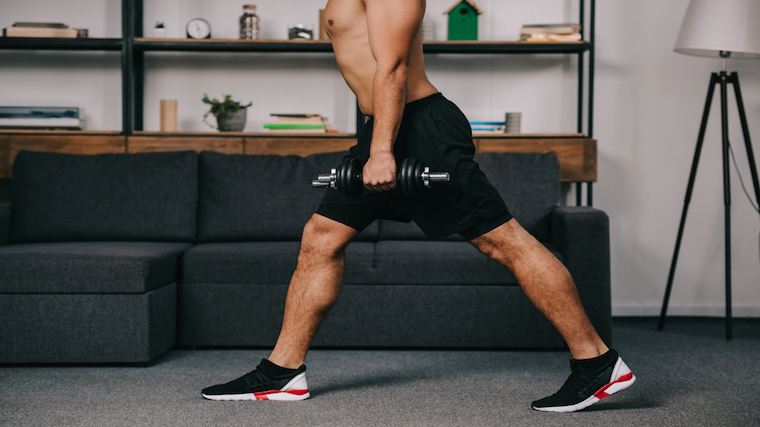
To stand back up, push through the floor with your front foot through your heel. You should feel your entire leg, but mainly your glutes, activate. Stand back to your starting position to complete a repetition, and repeat steps one through three.
Form tip: Your rear leg will contribute to the movement, but make sure that the front one is doing most of the work — around two-thirds of your body weight should be on the front foot.
Reverse Lunge Mistakes to Avoid
The off-balance nature of the reverse lunge can throw even the most experienced lifters off-kilter. Here are the most common reverse lunge mistakes and how to avoid them.
Rushing the Repetitions
When you’re holding a pair of dumbbells and kettlebells, the weight is subject to swing and gain momentum and throw your rhythm out of sync.
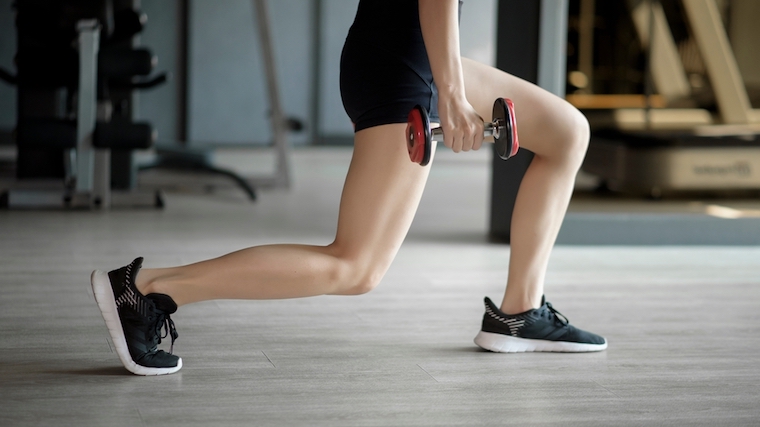
As there is a horizontal component with this movement, not controlling the reps will result in the weight moving backwards and forwards, causing balance problems and excessive lower back involvement.
Avoid it: Brace your entire body — squeeze your stomach, flex your lats, and contract your glutes — during each repetition. The weight should remain in a straight line under your shoulders.
Assuming a Narrow Stance
If your starting stance is too narrow, like if you were to walk on a line like catwalk models, you will probably lose balance and put stress on your hip joint. A wider base provides more stability and support.
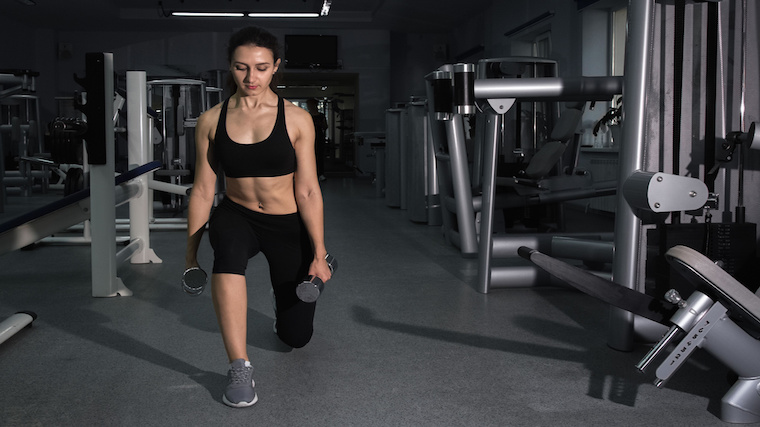
Avoid it: The ideal lunge stance should be around shoulder-wide. If you’re someone with wider hips, you might want to even widen your stance a little bit more to accommodate your pelvic structure.
Pushing With Your Back Leg
The majority of your weight should be on your front leg. If your back leg ends up doing most of the work, you will put unnecessary stress on the knee joint and greatly diminish glute involvement.
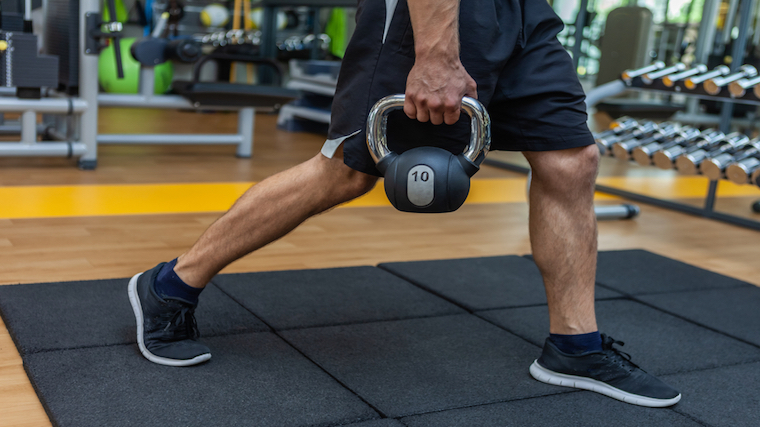
Because of the non-optimal position of the back leg, pushing with it will decrease the loading potential of the exercise, the athletic benefits of the lunges, and increase the risk of potential injuries.
Avoid it: You want the back leg to bear some of the load of your leg while keeping you balanced, but avoid pushing through the ball of your rear foot. Think of the front leg as the “working leg,” and the back leg as the “supporting leg.”
Rounding Your Back
Indeed, lunges are a lower-body exercise, but that doesn’t mean the involvement of the upper body isn’t crucial. It is. Your upper-body is supporting your upper weight, and proper core, back, and shoulder bracing is required if you want to maximally transfer the energy from the legs and move more weight.
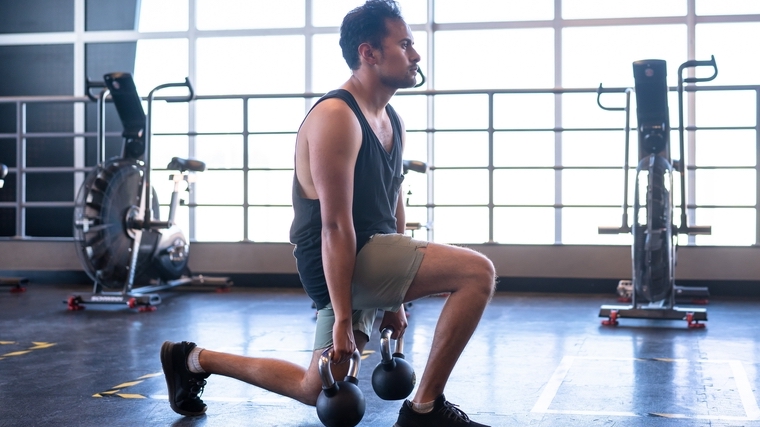
It is particularly true during the concentric (rising up) portion of the lift. If you don’t pay attention to your bracing, you risk hunching over, losing balance, and putting stress on your lower back, especially when fatigue sets in.
Avoid it: Flex your abs and tense your lat during the movement (think of squeezing something under your armpits). With heavier weights, you may take a deep breath before each rep and hold it until the hardest part of the concentric is over. This breath increases intra-abdominal pressure to make you more stable.
Reverse Lunge Benefits
The lunge is a basic unilateral exercise that has many benefits for all lifters. But why should we include it into a program instead of doing some other squat or a leg press? Here are three reasons.
Unilateral Strength
You’ll be hard-pressed to find a perfectly balanced lifter without any weakness. Skipping unilateral work (working the limbs separately) can create muscular and strength discrepancies, since lifters favor one side more than the other. Always using bilateral exercises might exaggerate these imbalances.
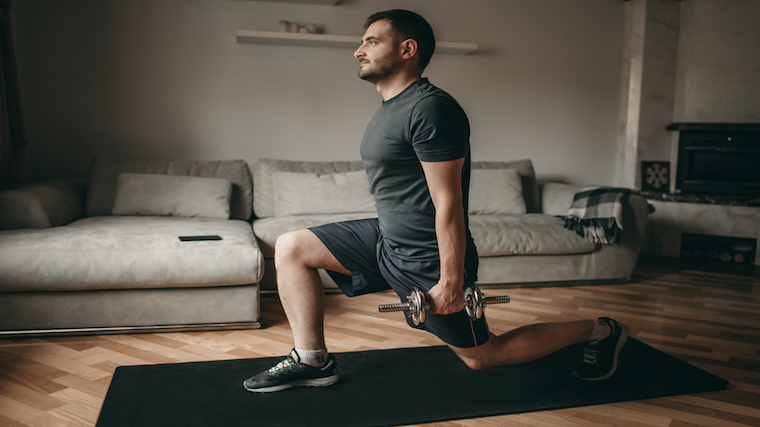
The inclusion of unilateral exercises will address your weak side so that they catch up with the strongest, both in size and/or strength. Coach’s tip: start each set with the weaker side so that it is less fatigued.
Improved Balance and Coordination
This benefit is more relevant to athletes, but unilateral exercises will vastly improve your balance, coordination, and motor abilities.
Most sports have their athletes perform actions on one limb at time, (for instance, when you run and change direction) so a unilateral exercise will have an additional carry over to performance and will help prevent injuries. (1) If you’re an average Joe with poor motor control, the reverse lunge will help you develop balance and body awareness — which are linked to longevity. (2)
An Easier, More Efficient Lunge
There are many ways to lunge, and the reverse lunge is promoted as one of the easier versions to perform — making it a prime choice for folks who want hypertrophy. (You can focus on taxing the muscle, not nailing your form.)
This exercise requires top shelf concentration and stability, and it is easier to control the eccentric and hold balance with a back step rather than a forward step. As such, this variation is preferred when weight (strength) or muscular tension (hypertrophy) are a main objective, for it’s more effective than the forward or walking lunge. (3)
Muscles Worked by the Reverse Lunge
Lunges are mainly a lower-body exercise, but don’t overlook the size and strength gains they help contribute in the upper-body. Let’s pass them in review.
Quadriceps
The quads are among the biggest and strongest muscles in the whole body. Their function is to extend the knees — straightening them from a bent position. In a lunge, they contribute to rising up from the bottom to the standing position.
To focus more on the quadriceps, take shorter strides and keep an upright torso.
Glutes
Thee glutes are heavily involved in the reverse lunge, as they are responsible for a multitude of roles in the hip joint. The gluteus maximus (the biggest muscle in the body) is the main hip extensor — it straightens the leg at the hip.
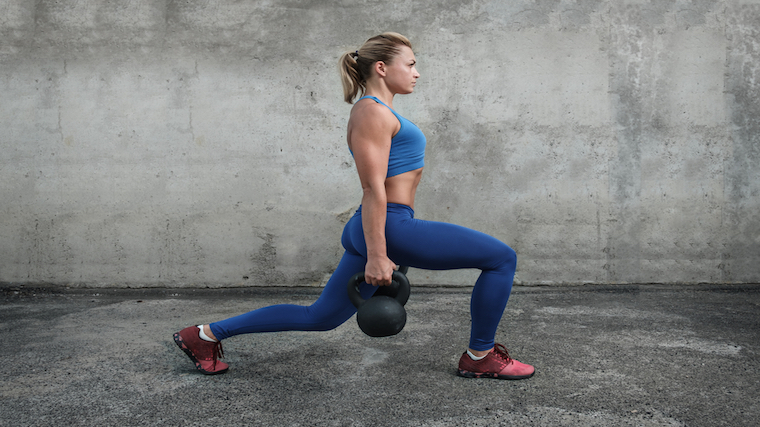
The gluteus medius and minimus will be tremendously involved in the lift’s stability, as they take care of hip balance by rotating and flexing it, and contribute to extending it. If you want to hit the glutes harder, bend a bit forward and take longer strides to really stretch them.
Hamstrings
The hamstrings are a series of posterior muscles that flex or bend the knees. Their main role in the lunge will be to ensure knee stability and flexion by acting in synergy with the quadriceps. But if you take long strides and/or bend forward, they will be more recruited also as hip extensors.
Adductors
Often overlooked, this series of five similar-functioning muscles are key to knee and hip balance in conjunction with the gluteus medius and minimus. They also help extend the knee and hips — especially the adductor magnus, the biggest of the five.
Erector Spinae
Also called the spinal erectors, people only think of them as the “lower back.” But it is in fact a complex muscle group that extends all the way to the skull. These postural muscles help keep the spine in place and also contribute to hip extension (just before coming back to the initial position).
Abdominals
The abs govern your torso movements — flexing forward, rotating, or bending to either side. Along with your erectors, they form the “core” and they are key to keeping proper posture and transferring energy from your legs to the weights efficiently.
Who Should Do the Reverse Lunge
The reverse lunge is an effective addition to any lifter’s arsenal. From the beginner starting their lifting journey to the athlete trying to get better at their sport.
Sports Athletes
Combining bilateral and unilateral exercises in an athlete’s training program might be the optimal way to improve performance. (4) The addition of unilateral movements to an athlete’s program is even more pertinent when they actually have to exert power one limb at a time in their sport — whether it’s running, jumping, tackling, or kicking. The agility and balance components of this exercise will have good carryover.
Bodybuilders and Aesthetic Enthusiasts
The reverse lunge is a natural choice for people wanting to pack on more size. Why not simply do more squats? Symmetry is of utmost importance to any physique enthusiast. As such, including unilateral exercises in your routine is paramount in order to avoid muscle imbalances and achieve symmetry and aesthetics.
Strength Athletes
Imbalances aren’t just detrimental to a physique, but also to performance. Developing strength and size of the lower body muscles is key to success for competitive powerlifters, strongmen and strongwomen, and CrossFit athletes. These sports require you to perform squats, deadlifts, and many leg exercises that will directly benefit from a unilateral lower-body staple.
How to Program the Reverse Lunge
The reverse lunge, being a unilateral and unstable exercise, is a bit more limited in its rep schemes because it would be unsafe and less efficient to program it using very heavy weights for very low repetitions. It shines as a muscle-building exercise.
Heavy Weight, Moderate Repetitions
Because of the lift’s nature, making it a main strength exercise and going extremely heavy is not safe. It is best suited as an assistance lift performed after your main barbell lifts. As such, two to four sets of five to eight repetitions per leg is ideal if you’re chasing strength.
Make sure to control the descent and prevent momentum, which is amplified when using heavy weights, to reduce the risk of injuries.
Moderate Weight, Moderate-to-High Repetitions
This is where the lunge thrives. Going a bit lighter for higher-rep sets allows the lifter to really reap the time under tension and balance-building benefits of the exercise. Three to five sets of 10 to 15 repetitions per leg will do the trick.
Keep in mind that such a long time under tension will highly tax your stabilizing, postural, and gripping muscles, providing a whole-body challenge.
Reverse Lunge Variations
As there are more than one way to skin a cat, you can perform the reverse lunge using a different equipment or even different weight placement to slightly modify the exercise and focus more on some muscles groups or goals.
Barbell Reverse Lunge
If the thought of moving heavy weight makes you froth at the mouth, just skip the dumbbells and use a barbell across your upper back. This will make the exercise more of a core challenge, because the weight is directly supported by your core instead of your shoulders, arms, and grip. A barbell will also allow you to use more weight eventually.
This is a great variation for building strength, and it’s especially useful when you don’t have dumbbells heavy enough or if you want to give your arms a rest without compromising leg training.
Zercher Reverse Lunge
In this variation, created by Ed Zercher, a St. Louis-based weightlifter from the 1930s, you hold a barbell in the crook of your elbows instead of across your back. Not only will you look like a badass, but this lift will provide your abs, upper back, and biceps a great workout. (5) This is the variation that will challenge your upper body the most.
The unique bar placement is particularly efficient for allowing longer-limbed lifters to stay upright or sink deeper more easily. It is a great way to lunge if you have poor mobility. If you want to really target the quads, it allows you to adopt a more upright posture while letting the knee track forward, which increases stress on the quad muscles.
Reverse Lunge Alternatives
Perhaps you’re the kind of optimist that never wants to go backwards, even during exercise. If you don’t feel like reverse lunging, here are some alternatives that will provide you similar benefits.
Bulgarian Split Squat
If you just want to provide your legs a good workout and have trouble keeping your balance during lunges, why not take some of the agility components out of it? This static exercise, sometimes called a rear-foot elevated split squat, elevates your non-working leg on a bench box, or step. It will still challenge your sense of balance, but it’s relatively easier.
Because the balance component is reduced, you’ll be able to use more weight, which can be useful if your goal is to gain more strength or power. The split squat is also great for bodybuilders who really want to emphasize their quadriceps and feel it burn without having to worry too much about losing balance.
Step-up
Now let’s do the opposite and make the exercise harder. The step-up will test your balance and coordination levels like no other. As such, it is a great tool for athletes. (6) To perform it, step on a box, a bench, or a pile of plates, with or without weights. Drive with your heel and slightly bend forward.
The higher the step, the harder the exercise will be. This exercise also targets your glutes significantly, especially with higher steps. (7) So if you want a bigger rear, don’t skip this variation.
Walking Lunge
The walking lunge is the lunge variation that will demand the most control and coordination, so it’s a great fit for athletes who want to incorporate a dynamic lower body exercise. It is also a great tool for building muscle size and endurance because of the long time under tension and constant movement.
Instead of traditional reps, you can also program this exercise for total distance, which is a great way to build work capacity (endurance or cardiovascular conditioning).
Unilateral Leg Press
This exercise requires the least balance of the bunch, so you can solely focus on your muscles. It is an excellent exercise to improve your mind-muscle connection or go to muscular failure.
Be sure to warm-up properly. Even though it requires less total-body balance, this exercise will demand good control and bracing from your hip muscles so that your pelvis stays in a stable and safe position.
FAQs
Should I let my knees travel past my toes? I’ve heard that can be bad for my joints.
Very few movements are actually “bad for the joints.” The lunge is a natural movement and it simply performs a normal knee function. It is not inherently dangerous, provided good form and appropriate loading is used. Make sure to keep your knee aligned with your toes and keep your shins in a vertical plane — do not let them cave in. Use variations with lesser knee angles at first as you develop basic strength and mobility.
You shouldn’t be afraid of letting your knees go past your toes. It is a natural and safe occurrence of knee flexion when performing any kind of squatting motion. However, the relation between your toes and knees will depend on your goal.If you want more quadriceps recruitment, let your knee travel past a bit more. If you want to emphasize your glutes, avoid it. Most importantly, if you have pre-existing knee injuries or if the exercise is painful, use a variation that won’t let your knee travel past your toes.
Can beginners do reverse lunges?
Of course. Beginners shouldn’t be afraid of this exercise. The added body awareness and agility benefits will pay in the long run and carry over to their health and proficiency in other exercises. Start with bodyweight lunges and, when you’re confident enough, start incorporating some weight.
Can I make lunges the main exercise of my leg workout?
You can. Some studies have actually shown no significant difference in terms of strength and power development between the squat and the lunge. (8) Rotating between unilateral and bilateral exercises as main lifts, or incorporating both in your routine, is a great strategy because they both have their own benefits.
Bilateral exercises often allow you to move heavier weights, which can help to build strength, while unilateral exercises address total-body coordination and help to address muscular imbalances or asymmetries.
Go in Reverse for Advanced Results
People usually avoid unilateral exercises because they seem harder to perform, but they offer too many advantages to be skipped. So put your best foot backwards and include the reverse lunge in your programming if you want bigger, stronger legs. You’ll end up being a more well-rounded, athletic, and balanced lifter.
References
- Speirs, Derrick E.1,2; Bennett, Mark A.3; Finn, Charlotte V.4; Turner, Anthony P.2 Unilateral vs. Bilateral Squat Training for Strength, Sprints, and Agility in Academy Rugby Players, Journal of Strength and Conditioning Research: February 2016 – Volume 30 – Issue 2 – p 386-392 doi: 10.1519/JSC.0000000000001096
- Araujo CG, de Souza e Silva CG, Laukkanen JA, et al Successful 10-second one-legged stance performance predicts survival in middle-aged and older individuals. British Journal of Sports Medicine Published Online First: 21 June 2022. doi: 10.1136/bjsports-2021-105360
- Sanghoon Parkq,Chulsoo Chungl, Jaebum Park,, Jonghyun Yang, Siddhartha, Bikram Panda, Jiseop Lee, Prabhat Pathak Comparative Analysis of Lunge Techniques: Forward, Reverse, Walking Lunge 34rd International Conference on Biomechanics in Sports, Tsukaba, Japan, July 18-22, 2016.
- Ramirez-Campillo, Rodrigo & Burgos, Carlos & Henríquez-Olguín, Carlos & Andrade, David & Martínez, Cristian & Álvarez, Cristian & Castro-Sepulveda, Mauricio & Marques, Mário & Izquierdo, Mikel. (2015). Effect of Unilateral, Bilateral, and Combined Plyometric Training on Explosive and Endurance Performance of Young Soccer Players. The Journal of Strength and Conditioning Research. 29. 1317–1328. 10.1519/JSC.0000000000000762.
- Kumar, Satheesh & Perumal, Suriya & Subramani, Arumugam. (2020). Influence of Zercher Squat Exercises on Back Strength and Leg Strength among College Basketball Players. Journal of Information and Computational Science. 10. 45-50. 10.12733/JICS.2020.
- Appleby BB, Newton RU, Cormack SJ. Kinetics and Kinematics of the Squat and Step-up in Well-Trained Rugby Players. J Strength Cond Res. 2019 Jul;33 Suppl 1:S36-S44. doi: 10.1519/JSC.0000000000003055. PMID: 30707142.
- Neto WK, Soares EG, Vieira TL, Aguiar R, Chola TA, Sampaio VL, Gama EF. Gluteus Maximus Activation during Common Strength and Hypertrophy Exercises: A Systematic Review. J Sports Sci Med. 2020 Feb 24;19(1):195-203. PMID: 32132843; PMCID: PMC7039033.
- Scott, Shaul. (2016) Which is Better for Building Strength, Power and Agility: Squats or Lunges? Mountain tactical Institute.
Featured Image: UfaBizPhoto / Shutterstock
The post How to Do the Reverse Lunge for Powerful Legs and Rock-Hard Glutes appeared first on Breaking Muscle.
Filed under: Fitness

 For now classes are 6pm and 640pm at 2840 Wildwood st in the Boise Cloggers studio.
Book your class NOW!
click this ==>
For now classes are 6pm and 640pm at 2840 Wildwood st in the Boise Cloggers studio.
Book your class NOW!
click this ==>








